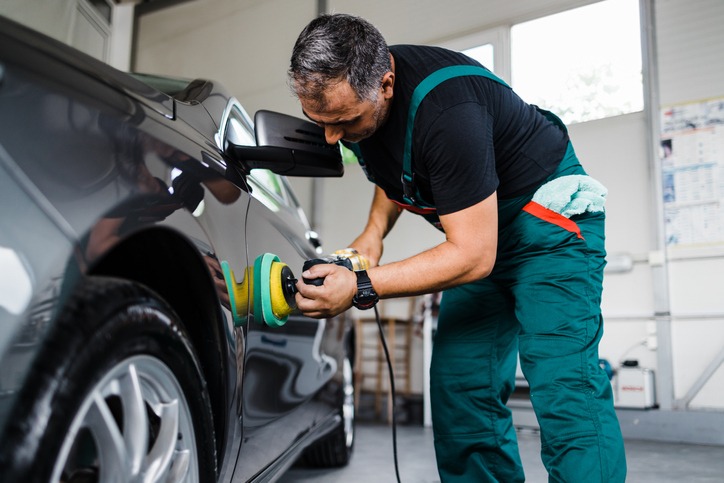Your car’s paint job is one of the most important features that can impact its resale value, and it is essential to protect the paint from the elements to keep it from deteriorating in any way. When the exterior of your car begins to decay, restorative measures will need to happen, such as paint chip repair, in order to maintain your car’s appearance. But preventative actions can be taken before expensive exterior restoration is necessary.
Find out how to provide protection for your car’s paint, including tips on washing, waxing, and applying paint protection films.
Washing
Regular washing is essential to keep your car’s paint looking faultless and is a conducive way to maintain the exterior and paint job of the vehicle. Although some may think washing a vehicle only involves water and soap, this procedure consists of more steps that will help keep the vehicle’s paint maintained. The following tips should be heeded when washing your car for paint protection purposes:
- Use a gentle car shampoo: Avoid using dish soap or other household cleaners, which can damage the paint.
- Use a microfiber cloth or mitt: A soft microfiber cloth or mitt will help to prevent scratches and swirl marks.
- Wash in the shade: Washing in direct sunlight can cause water spots and can make it harder to see dirt and grime.
- Rinse thoroughly: Rinse your car thoroughly to remove all soap residue.
Waxing
Waxing your car with ceramic coating can help to protect the paint from the various elements it is often exposed to and can give it a shiny, glossy finish. The following tips can make for a more effective waxing session and keep your car looking glossy and gleaming for longer:
- Use a high-quality ceramic coating: Look for a type of ceramic coating that is designed specifically for cars and contains UV inhibitors to protect the paint from the sun.
- Apply ceramic coating in a cool, shaded area: Avoid this process in direct sunlight, which can cause the ceramic coating to dry too quickly and can leave streaks.
- Apply the ceramic coating in a thin, even layer: Use a microfiber cloth to apply the ceramic coating in a thin, even layer, working in small sections at a time.
- Buff the ceramic coating off with a clean microfiber cloth: Use a clean, dry microfiber cloth to buff off the ceramic coating, working in circular motions.
Paint Protection Films
Paint protection films are a great way to protect your car’s paint from scratches, rock chips, and other damage when implemented on your vehicle in the proper manner. Incorporate the following helpful tips into your paint protection film installation procedure for maximum longevity and protection:
- Clean the surface: Thoroughly clean the surface of your car’s paint to remove any dirt, grime, or wax.
- Cut the film to size: Use a razor blade or other cutting tool to cut the film to the correct size and shape.
- Apply the film: Peel the backing off the film and apply it to the surface of the car, smoothing out any bubbles or wrinkles.
- Trim the edges: Use a razor blade to trim any excess film from the edges of the car.
Other Tips for Protecting Your Car’s Paint
- Use a car cover: Using a car cover can help to protect your car’s paint from the elements, including sun, rain, and dust.
- Park in the shade: Parking in the shade can help to protect your car’s paint from the sun, which can cause fading and oxidation.
- Avoid harsh chemicals: Avoid using harsh chemicals, such as bleach or ammonia-based cleaners, on your car’s paint, as they can damage the finish.
- Fix chips and scratches: If you notice any chips or scratches in your car’s paint, have them repaired as soon as possible to prevent further damage.
Additional Factors to Consider
One additional tip for protecting your car’s paint is to avoid automatic car washes that use brushes or harsh chemicals, as these car washes can ultimately cause scratches and swirl marks on your car’s paint, which can be difficult to remove. Instead of going to just any car wash, consider using touchless car washes or washing your car by hand using the techniques outlined above. These alternatives will help to prevent damage to your car’s paint and keep it looking new and shiny.
Another important factor in protecting your car’s paint is to be mindful of where you park. Avoid parking under trees or near construction sites where your car could be exposed to falling branches or debris. Additionally, be careful not to park too close to other vehicles or objects that could scratch or dent your car’s paint. By taking these additional steps to protect your car’s paint, you can ensure that it remains in top condition and retains its value over time.
Conclusion
Protecting your car’s paint is essential, so your car can retain its appearance without unsightly deterioration emerging over time and avoid having to get expensive repairs, such as paint chip repair. Regular washing and waxing, along with the use of paint protection films, car covers, and proper parking techniques, can help to protect your car’s paint from the elements. Following these tips can help you keep your car’s paint looking fresh and shiny for years to come.

